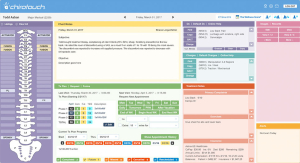Chiropractic EMR software has proven to be a transformative step, streamlining operations, improving documentation, and ultimately contributing to a more seamless approach to patient care.
Understanding Chiropractic Practice Needs
Chiropractic care emphasizes a non-invasive, hands-on approach to health, focusing on the musculoskeletal system and its impact on overall well-being. Chiropractors aim to alleviate pain and improve functionality through manual adjustments, therapeutic exercises, and patient education. The personalized nature of chiropractic care demands a comprehensive approach to patient information management. This makes Electronic Medical Records (EMR) software an invaluable tool in modern chiropractic practices.
EMR Software Promotes Seamless Patient Information Management
One of the primary benefits of EMR software in chiropractic practices is the ability to manage patient information seamlessly. Traditional paper-based systems often lead to inefficiencies, with physical files being misplaced or information being difficult to access. EMR software centralizes patient data, allowing chiropractors and their teams to access comprehensive records with just a few clicks.
Through the implementation of EMR software, chiropractors can easily track a patient’s medical history, treatment plans, and progress over time. This seamless information management enhances the quality of care and enables informed decision-making for both short-term and long-term treatment strategies.
Efficient Appointment Scheduling
Appointment scheduling is crucial to chiropractic practices, and EMR software brings a new level of efficiency to this process. Automated scheduling reduces the likelihood of double bookings, optimizes appointments based on practitioner availability, and minimizes no-shows through patient reminders.
Chiropractors can also integrate EMR software with billing and insurance information, streamlining the administrative tasks associated with appointments. This saves time for both staff and patients and ensures a more organized and punctual workflow within the clinic.
EMR Software Enhances Documentation and Compliance
Accurate and thorough documentation is essential in chiropractic care, and EMR software excels in this regard. Chiropractors can easily create, update, and store digital records of patient encounters, ensuring that no vital information is overlooked. Moreover, EMR systems often come with built-in templates designed specifically for chiropractic documentation, streamlining the process and maintaining consistency.
In addition to improving documentation practices, EMR software assists chiropractic practices in maintaining compliance with healthcare regulations. The software automatically updates as per industry standards, helping clinics stay abreast of changes in requirements and avoid non-compliance penalties.
Interconnectivity and Collaboration
The interconnected nature of EMR systems facilitates seamless collaboration among healthcare professionals. Chiropractors can easily share patient information with other healthcare providers, fostering a more holistic and collaborative approach to patient care. This interconnectivity is particularly beneficial in cases where a patient is receiving concurrent treatment from multiple practitioners. It ensures that everyone involved is well-informed about the patient’s progress and treatment plan.
Furthermore, EMR software enables secure communication within the clinic, allowing practitioners and support staff to exchange information and updates efficiently. This real-time collaboration contributes to a more coordinated and patient-centric approach to healthcare.
EMR Software Telehealth Integration
Telehealth has become increasingly prevalent, and chiropractic EMR software provides a foundation for the seamless integration of virtual consultations. Chiropractors can conduct remote assessments, monitor patient progress, and provide guidance on therapeutic exercises through secure online platforms.
The ability to integrate telehealth services into the EMR system expands access to care and enhances the overall patient experience. Patients conveniently connect with their chiropractors from home, reducing the need for travel and ensuring continuity of care.
Data Analytics for Informed Decision-Making
EMR software goes beyond basic record-keeping; it also serves as a valuable tool for data analysis. Chiropractic practices can leverage data stored in the system to gain insights into patient outcomes, treatment effectiveness, and clinic performance. By harnessing data analytics, practitioners can make informed decisions about treatment protocols, resource allocation, and overall practice management.
For example, clinics can identify patterns in patient responses to specific treatments, allowing for the refinement of therapeutic approaches. Additionally, data analytics can inform strategic decisions related to marketing, resource allocation, and the introduction of new services. This contributes to the growth and success of the chiropractic practice.
EMR Software Security and Privacy Considerations
The adoption of EMR software raises concerns about the security and privacy of patient information. Chiropractors must prioritize platforms that adhere to industry-standard security measures and comply with healthcare data protection regulations. Encryption, user authentication, and regular system audits are essential features that ensure the confidentiality and integrity of patient data.









